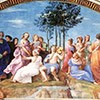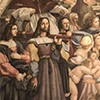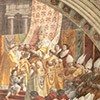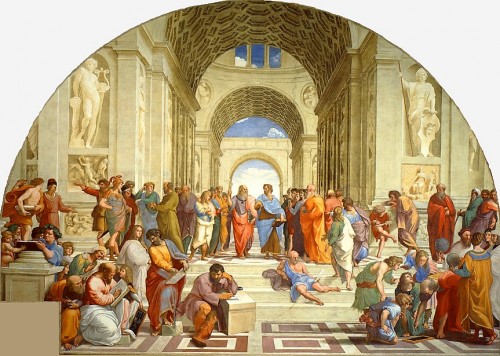
The School of Athens, Raphael, Stanza della Segnatura, Apostolic Palace, pic. Wikipedia

Stanza della Segnatura, vault, Apostolic Palace

The Cardinal Virtues, Raphael, Stanza della Segnatura, Apostolic Palace, pic. Wikipedia

Image of Pope Julius, fragment of the fresco The Cardinal Virtues, Raphael, Stanza della Segnatura, Apostolic Palace

The Parnassus, Raphael, Stanza della Segnatura, Apostolic Palace, pic.Wikipedia
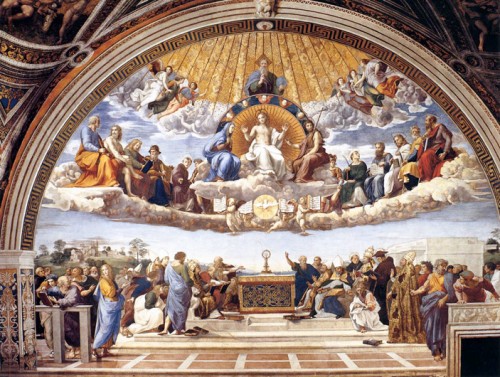
Disputation of the Holy Sacrament, Raphael, Stanza della Segnatura, Apostolic Palace, pic. Wikipedia

The Expulsion of Heliodorus from the Temple, Raphael and his workshop, Stanza di Eliodoro, Apostolic Palace, pic.Wikipedia

The Expulsion of Heliodorus from the Temple, fragment, Raphael and his workshop, Stanza di Eliodoro, Apostolic Palace

The Mass at Bolsena, Raphael and his workshop, Stanza di Eliodoro, Apostolic Palace

The Mass at Bolsena, fragment, Raphael and his workshop, Stanza di Eliodoro, Apostolic Palace

The Meeting of Leo the Great and Attila, Raphael and his workshop, Stanza di Eliodoro, Apostolic Palace, pic.Wikipedia

Deliverance of Saint Peter, Raphael and his worshop, Stanza di Eliodoro, Apostolic Palace, pic.Wikipedia
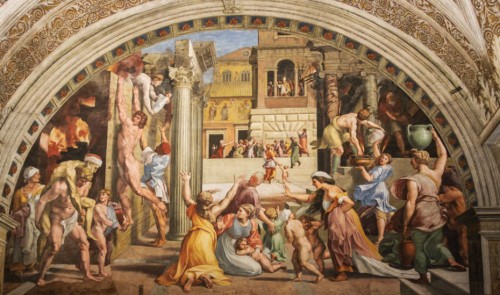
Fire in the Borgo, Stanza dell’Incendio di Borgo in the Apostolic Palace

The Battle of Ostia, Raphael and his workshop, Stanza dell’Incendio di Borgo, Apostolic Palace

The Coronation of Charlemagne, Raphael and his workshop, Stanza dell’Incendio di Borgo, Apostolic Palace, pic.Wikipedia

The Oath of Leo III, Raphael and his workshop, Stanza dell’Incendio di Borgo, Apostolic Palace, pic.Wikipedia

The Vision of the Cross, workshop of Raphael, Stanza del Constantino, Apostolic Palace, pic. Wikipedia

The Battle of the Milvian Bridge, fragment, Giulio Romano and his workshop, Stanza del Constantino, Apostolic Palace, pic. Wikipedia

The Baptism of Constantine, Raphael's workshop, Stanza del Constantino, Apostolic Palace, pic. Wikipedia

The Donation of Constantine, Gianfrancesco Penni or Giulio Romano, Stanza del Constantino, Apostolic Palace, pic. Wikipedia
Here we have only a twenty-five-year-old artist appearing in front of Pope Julius II, and the pontiff entrusts him with creating the painting decorations for one of his apartments (stanza in Italian) – a study and a library in one. Its theme was to be showing the universum of human knowledge, symbolized by philosophy, theology, law, and poetry. The works in the room had already been started by a group of painters with well-grounded fame (Sodoma, Lorenzo Lotto, Baldassare Peruzzi). However, the fresco completed by Raphael (The School of Athens) was so much to the pope’s liking that he relieved all the other painters of their duties and entrusted Raphael with all of the decorations in this room.
Here we have only a twenty-five-year-old artist appearing in front of Pope Julius II, and the pontiff entrusts him with creating the painting decorations for one of his apartments (stanza in Italian) – a study and a library in one. Its theme was to be showing the universum of human knowledge, symbolized by philosophy, theology, law, and poetry. The works in the room had already been started by a group of painters with well-grounded fame (Sodoma, Lorenzo Lotto, Baldassare Peruzzi). However, the fresco completed by Raphael (The School of Athens) was so much to the pope’s liking that he relieved all the other painters of their duties and entrusted Raphael with all of the decorations in this room.
The pope had once again trusted his artistic intuition – let us recall, that, he had recently done so, entrusting the painting decoration of the vault of the Sistine Chapel to Michelangelo. The pope’s decision should come as no surprise, as he stood in front of Raphael’s fresco and found himself in a monumental interior of an ancient basilica, filled with figures of philosophers, who seem to be entering his apartment. Equally, the lyrical impression and naturalness of the scene left no doubt, that an artist who could artistically match the great Michelangelo had come to Rome.
The windows of the stanzas planned by the pope were directed at the courtyard of the Belvedere and let in a lot of light, which could illuminate the frescoes, with which the pope desired to decorate his apartments. It was the intent of Julius II to create three private rooms (in the enfilade) on the second floor of the Apostolic Palace, exactly above those of the first floor, which were in the past decorated by the frescoes of Pinturicchio at the behest of Pope Alexander VI. A deep dislike of his predecessor, but also the desire to leave behind something significant, played an important role in the pope’s way of thinking. Unfortunately, Julius II did not live long enough to enjoy these beautiful interiors; until his death he had to live in the Borgia rooms.

Meanwhile, Raphael worked on subsequent walls of the Stanza della Segnatura, creating the frescoes The Parnassus and The Disputation on the Holy Sacrament, which had once again aroused admiration and consolidated their author’s fame in Rome. He quickly became the court painter of the pope with a steady salary, while the impatient pope entrusted him with another apartment to decorate (Stanza di Eliodoro). It was his wish that the frescoes depict the divine intervention into human fate and the history of the Church. The scenes painted there are no longer as classic and as uniform as the previous ones, however, they would become a source of iconographic motifs for future generations. We must begin with the fresco showing the expulsion of Heliodorus from the temple, a story from which the apartment takes its name. At the very moment when Heliodorus on horseback enters the Jerusalem Temple at the head of his armies, an angel sent by God appears, driving off the invaders and in this way saving the holiest of places from being looted and desecrated. The following scene shows Pope Leo I, who with the aid of the accompanying apostles Peter and Paul defeats the barbarian hordes of Attila and saves Rome from being sacked. On the other hand, The Mass at Bolsena relates to a miracle that took place in 1263 and made a doubting priest aware of the presence of Christ in the Eucharist. However, the most beautiful fresco is the one depicting St. Peter (The Deliverance of St. Peter), in which Raphael and his collaborators created a moving scene, based on a refined play of light.
Desiring to facilitate Raphael's work and accelerate the painting process, the pope allowed him to introduce a sort of an assembly line. First Raphael created a sketch of the planned scenes, then he drew the individual figures, often taking advantage of a study of a model, and at the end, he created a natural size cartoon, which was replicated on the wall by his collaborators responsible for the individual scenes, figures, details, and colors. Raphael supervised it all, appropriately correcting each scene when needed. His collaborators were responsible for finishing the frescoes and framing them with stuccos, however, the painter left a lot up to them. In time his participation in the works on the frescoes would gradually decrease.
Julius II, anticipating his impending death, impatiently waited for the works to be finished. When his time to bid farewell to the world came in 1513, he was able to see the finished masterpiece of Michelangelo, however, the papal apartments were far from complete. Raphael concluded the works on the Stanza di Eliodoro during the pontificate of the next pope, Leo X. This humanist and art enthusiast praised by the then elites, fascinated with Raphael’s painting, also ordered him to complete decorations of another apartment. The result was the Stanza dell’Incendio di Borgo, which was to serve as a dining room. It must be assumed that Leo X actively participated in the creation of the iconographic program of the frescoes, whose theme was to be the recalling of his namesakes on the papal throne – Leo III and Leo IV, in whose images we will notice the portrait of the client himself. In this apartment, Raphael's active participation is only attributed to the creation of the fresco The Fire in the Borgo, from which the room takes its name. And there can be no doubt – both the muscular figures of the men, as well as the expression and dramaturgy of his vision, were an artistic copy of Michelangelo. Works on other frescoes were entrusted in full to Raphael's students (Giulio Romano, Gianfrancesco Penni).

Leo X, inspired by the idea of the decoration of the papal chambers, decided to create yet another apartment, this time a larger one which would serve both representative and ceremonial purposes. In this way, the Stanza di Constantino was created. Works on it began in 1519. Documents indicate that Raphael was influential in creating the painting program for this room, although his involvement was limited. The men responsible for the decoration were once again Giulio Romano and Gianfrancesco Penni. The topic of the paintings is the deeds of Constantine the Great – the first Christian Roman emperor. It must be assumed that two of these were shaped while Raphael was still alive: The Battle of the Milvian Bridge and The Vision of the Cross. The two remaining ones were not created until after 1520, which can be testified to by the portrait of the subsequent pope, Clement VII, who like his predecessor had Pope Silvester I created in his image.
Raphael worked on the frescoes in the papal apartments until his death (1520). The so-called Raphael’s Stanzas are the work of three popes and a group of outstanding painters, who were led by the master from Urbino. His input into the decorations was significant, but they would not have been created without his outstanding collaborators and students such as the aforementioned Penni and Romano, but also Perino del Vega or Polidorio da Caravaggio. The chief coordinator of the works was Giulio Romano – Raphael’s friend and an artist of exceptional talent, whose star would soon shine brightly in the firmament of art. Most of these artists (besides Penni), would after 1527 spread all across the Apennine Peninsula and begin their careers, utilizing everything they had been taught by Raphael in Rome.
Works on the frescoes lasted until 1524. Those who commissioned them, the popes Julius II and Leo X never saw them in their full glory. The first bishop of Rome who had the pleasure of living there was Clement VII, however, he enjoyed them only until 1527, meaning the famous looting of the chambers by the landsknechts of Emperor Charles V (Sacco di Roma).
Raphael’s frescoes in the Apostolic Palace
- Stanza della Segnatura, 1511 (The Disputation of the Holy Sacrament, The School of Athens, The Parnassus, Cardinal, and Theological Virtues)
- Stanza di Eliodoro, 1514 (The Expulsion of Heliodorus from the Temple, The Deliverance of St. Peter, The Meeting of Leo the Great and Attila)
- Stanza dell’Incendio di Borgo, 1517 (The Fire in the Borgo, The Battle of Ostia, The Coronation of Charlemagne, The Oath of Leo III), design and sketches
- Stanza del Constantino, 1524 (The Battle of Milvian Bridge, The Vision of the Cross, The Baptism of Constantine, The Donation of Constantine)
If you liked this article, you can help us continue to work by supporting the roma-nonpertutti portal concrete — by sharing newsletters and donating even small amounts. They will help us in our further work.
You can make one-time deposits to your account:
Barbara Kokoska
BIGBPLPW 62 1160 2202 0000 0002 3744 2108
or support on a regular basis with Patonite.pl (lower left corner)
Know that we appreciate it very much and thank You !

























